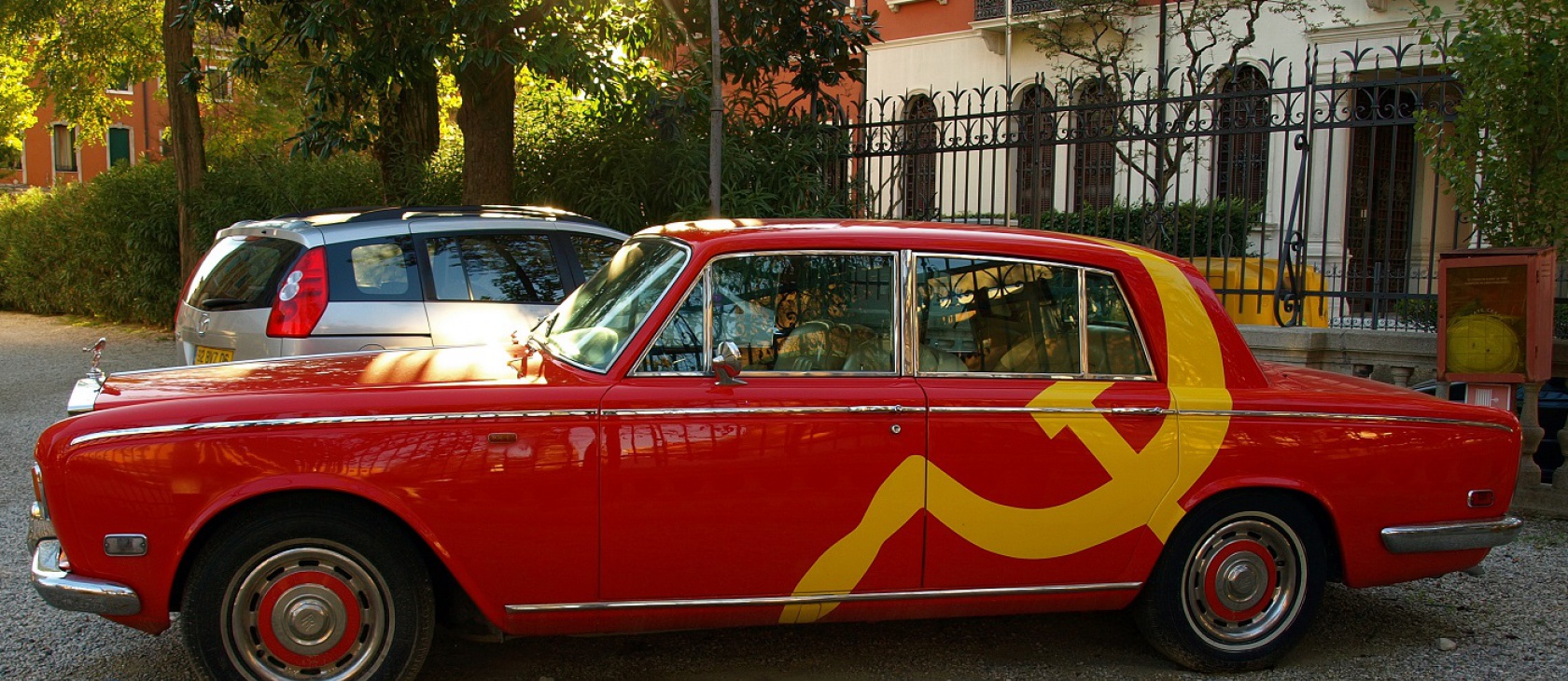November 7, 2017: Exactly 100 years after the Bolshevik Revolution, thousands of Communists marched in Moscow’s city centre under the infamous red banner, carrying portraits of Lenin and Stalin, celebrating “the most important event for humanity.” Among them are dozens of Italian militants, delegations of three little Communist parties: the new Communist Party led by Marco Rizzo, the Communist Refoundation Party led by Maurizio Acerbo, and as many as 80 delegates of the renewed Italian Communist Party led by Mauro Alboresi. Four days later, Rizzo led a public celebration in Rome, which started at the Coliseum. Many events in Italy, from North to South, marked this Revolutionary Jubilee. In Lecce conferences, exhibitions and shows organized by the ARCI (the post-Communist youth cultural organization) included important guests like former premier Massimo D’Alema. On the opposite side of Italy, in Varese, the local Communist cultural centre hosted “Varese Celebrates the October Revolution,” with poetry, art exhibitions and music.
Today, nearly a century after the founding of the Italian Communist Party (ICP) by Antonio Gramsci in 1921, few Italian Communists want to use that name. Their parties have little or no representation in local and national institutions. Nonetheless, Communism in Italy is the biggest “elephant in the room” in Italian politics, exerting an influence even to this day.
Every educated Italian is still influenced by Marxism.
The cause is not only deeply embedded in Italian history – e.g., Communist partisans contributed to win World War II against the Nazis. The cause is also cultural. History teachers use manuals written by Rosario Villari, a recently deceased Marxist academic, and his comrades. Poets and great writers of our modern literature such as Pier Paolo Pasolini, Leonardo Sciascia, just to name few, were Marxists or influenced by Marxism. The most important movie directors, Rossellini, Visconti, Antonioni, Bertolucci, where all Marxists or pro-Marxist with far-Left views. In Marxist fashion, they infused their writings with their political views. As a result, every educated Italian is still influenced by Marxism.
The cause is also political, as the nation’s Communist Party had a significant role in national governance – and its former members still do. The ICP received an average of 30 percent of the Italian vote from 1946 to 1989. They did not simply disappear after 1989, when ICP changed its name to the Democratic Party of the Left. More than half of the leaders in our majority party, the Democratic Party, were Communists just 27 years ago. Former Italian President Giorgio Napolitano was a prominent ICP leader who, in 1956, praised the Soviet invasion of Hungary. In our present government, almost all key ministers are former Communists: Anna Finocchiaro (Parliament Liaison Minister), Marco Minniti (Homeland Security Minister), Andrea Orlando (Justice Minister), Roberta Pinotti (Defence Minister), Giuliano Poletti (Minister of Work), Valeria Fedeli (Minister of Education). The premier, Paolo Gentiloni, is a former militant of the Worker’s Movement for Socialism, an extreme left-wing organization of the 1970s inspired by Mao Zedong. The founder of Democratic Party, Walter Veltroni, declared “I have never been a Communist” – but he was the leader of FGCI, the Communist Youth Federation, before he became an ICP Member of Parliament.
A history of terror
The ICP was not comparable to any Socialist or Labour Party in Europe and was always loyal to the USSR, which trained select ICP personnel and which continued to financially support the ICP even after the “break” by secretary Enrico Berlinguer. (See Valerio Riva’s Gold from Moscow.) During 1945 to 1947, territories ruled by Communist partisans were governed like the Soviet Union, including purges and Red Terror. Estimates place the number of people executed in the thousands, although detailed accounts are still impossible. We know only scattered individual cases of their victims – such as Rolando Rivi, a 14-year-old seminarian who was kidnapped, tortured, and killed by Communists, because he refused to deny his faith. He was beatified in 2013. We also know of Giuseppina Ghersi, a 13-year-old girl murdered by the partisans.
Marxism created Italy’s “fake news” phenomenon
After the 1948 elections, the first democratically elected government excluded the ICP, which settled into a political focus. But by the late 1960s, revolutionary tactics resumed from the Red Brigades, who killed and injured “class enemies,” internal dissidents, government officials, political enemies, journalists, and intellectuals. The years from its formation until 1982 were known as “Years of Lead.” The ICP never endorsed the Red Brigades, but it did not fight them until the 1978 kidnapping and assassination of Christian Democrat premier Aldo Moro.
The Communist heritage remains particularly strong, because the party created an alternative “church” to the Roman Catholic Church.
This part of Italian modern history is still taboo. In popular culture, Soviet and Communist “desinformacija” is still part of many conspiracy theories about history and politics. It’s still widely believed that Americans coordinated the Red Brigades in order to discredit the ICP and that Moro was assassinated by a CIA conspiracy. All those theories were fabricated by the KGB, as the Mitrokhin dossier clearly demonstrates, but they are still part of the Italian political culture.
The Communist Party: An alternative church
The Communist heritage remains particularly strong, because the ICP created an alternative “church” to the Roman Catholic Church. Communist children attended Communist Youth events - hosted either by the Party-led FGCI or the more independent ARCI (which also organized activities for adults). “Parish life” took place at party functions, where lectures and “debates” explained current events from a Communist point of view. The ICP unofficially “owned” the third channel of public TV, owned its own newspaper (L’Unità), and influenced many other “independent” outlets. The Communist “church” had also its own seminar: the “Frattocchie” School of politics. Strict Communist militants even refused to drink Coke, or watch American movies or TV shows, even cartoons. The strict Communist militant built his own culture with Soviet movies and literature, Communist news media and recreational activities. It was a world apart which still continues in some sectors.
Subverting justice
One great heritage of Communism is the judiciary populism (“giustizialismo” in Italian), which is well entrenched in the media, left-wing politics, and part of the judiciary. According to those populists, a defendant is not guilty because the proof condemns him; he’s guilty because he belongs to a disfavoured social class. Theft is illegal, but criminal penalties for burglaries are astoundingly light, compared to other crimes. Self-defence, on the other hand, is strictly regulated, and the home owner who tries to defend his life and his private property is often accused of homicide.
Personal and family independence: The biggest foe
Another heritage of Communism is the continuous struggle against the Church, traditional values, and the family. Anti-clericalism, though now weaker, remains entrenched in pockets of Italian culture. The ICP staunchly fought against sexual rights, early on – Party Secretary Palmiro Togliatti was against legalizing divorce, and the party expelled the poet Pier Paolo Pasolini because of his homosexuality – but since the 1980s, the Communists and their heirs have supported these “new rights” as an important tool against the family and “bourgeois” values.
The struggle against the family rages most fiercely in the government’s opposition to any form of free (i.e., non-State) education and the imposition of a high taxes on families. High taxation on home ownership is another part of this comprehensive post-Communist battle against the family. The main characteristic of local and national left-wing governments is always the imposition of new taxes on home ownership at the local level and confiscatory tax rates on the national level.
In these and other ways, the Communist Revolution continues to influence Italy.
(Photo credit: Craig Morey. This photo has been cropped. CC BY-SA 2.0.)




